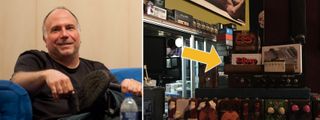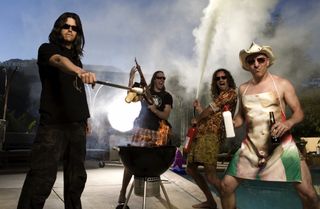On May 1, 2006, Tool released their album 10,000 Days in the UK.
Recorded in O’Henry Studios in Burbank, California between August and December of the previous year, the band self-produced their fourth studio effort with producer Joe Barresi, who engineered and mixed the tracks.
We visited Joe at his Pasadena studio to talk about his experiences working on 10,000 Days, and found him surrounded by souvenirs and curios from his career, which includes credits with Kyuss, Melvins, Nine Inch Nails and Parkway Drive.
There are Spinal Tap dolls on the table, boxes of monogrammed guitar picks, and a battered, flame-shaped guitar hanging on the wall. Joe was working in a different studio in Hollywood when he mixed this particular album, but he’s brought the memories with him; the homemade ‘pipe bomb’ mic used during recording sits on a shelf above his mixing desk.
What the hell is a ‘pipe bomb’ mic? And what did Tool force every studio visitor to watch for their own amusement?
Joe explains this and more, as he shares his memories of working with the band on this landmark release…
How did the recording process for 10,000 Days begin?
Joe Barresi: “When I met the band for the first time, I remember standing outside their rehearsal room with their manager waiting for a song to end before we walked in. It sounded like eight guys were playing in that room. I thought Maynard must have been playing some percussion as well but that was all Danny [Carey, drums] – it blew my mind how he was triggering sounds in a computer by integrating the Mandala pads into his drum kit. I attended rehearsals for about a month to get to know the music better, and would take notes on when parts felt great and what may have been different. There’s no playing to a click track in that band, they’re so tuned into each other and it was incredible how they locked in and took the music to another level. I was trying to learn the arrangements and understand what they were playing; the time signatures and accents were a real challenge for me and the sheer power of the band in rehearsal was something I wanted to make sure we got on tape.”
Did the band tell you exactly how they wanted the album to sound?
“During rehearsals I’d listen and observe what the guys were playing, and ask if there was anything in their wildest imaginations they’d want to try. Then I’d have it built or bring gear by that might do the trick. Justin [Chancellor, bass] had played thru a Gallien-Krueger amp somewhere while guesting on another record so he was trying them out. Adam had an idea for a pedal that would crossfade sound from dry to wet, so I had a few different ones made until the guys at Barge Concepts made one that worked flawlessly. Maynard and I spoke of recording his voice in weird ways, and that’s where the pipe bomb mic came into being. It was a guitar pickup mounted onto a piece of pipe. It didn’t work at all for vocals but ended up on a guitar solo and sounded wild. Personally I thought the song Stinkfist off of Ænima was the perfect sounding Tool song so I used that as a benchmark, but with even more aggression if that was possible.”

You called in Bob Heil (inventor of the talkbox) and Joe Walsh from the Eagles to advise on the talkbox guitar solo on Jambi. What kind of things did they suggest?
“Basically, we’d been trying out some of the Heil mics and we were introduced to Bob via the company that loaned us the gear. When it was time to cut the solo, we had listened to so many famous talkbox solos and Joe Walsh’s sound was the one that was the closest to what we were after. So we asked Bob if he could make the introduction, and Joe called Adam one day and told him some of the tricks he had used in the past to make his talkbox sound so rad. It was a really cool moment to get tips from a master like that.”
Apart from the ‘pipe bomb’ was there any other kind of DIY experimentation?
“There was loads of experimentation. We recorded to tape so the intro to The Pot was actual print-through. I got that cool pre-echo the natural way, not with digital gimmicks. I had Maynard sing into snare drums with the heads resonating, recorded vocals an octave high or low and at different speeds, then slowed them down (or sped them up) on tape to alter the pitch and timbre of his voice. We recorded some bass parts by mic-ing Justin’s fingers… There were so many things.”

10,000 Days is known as a very spiritual album, with the title referring to Saturn’s orbit. Did you have any conversations about deep, philosophical topics while you were in the studio?
“The only spiritual moment for me was when Maynard sang the song Wings For Marie [which references his mother’s illness]. He didn’t have to say what it was about, I got chills because his performance and the lyrics were so emotional. He really delivered a memorable vocal and we both had to take a break after that one.”
What was the most memorable moment in the studio?
“There were many memorable moments, but I can just say this – hanging out with those guys was a pleasure. We didn’t disagree, I was there to facilitate whatever it was they were trying to achieve. We were friendly during the making of the record and still are to this day – although nothing is as close to being in a room with someone for 12 hours a day. We played a lot of Guitar Hero; I remember that game coming out back then and I turned the guys onto it. That was a good pastime in the lounge, as well as making anyone who came to the studio sit through R. Kelly’s Trapped In The Closet DVD. Priceless entertainment.”
Why Maynard James Keenan Would Rather Make Wine Than A New Tool Album

